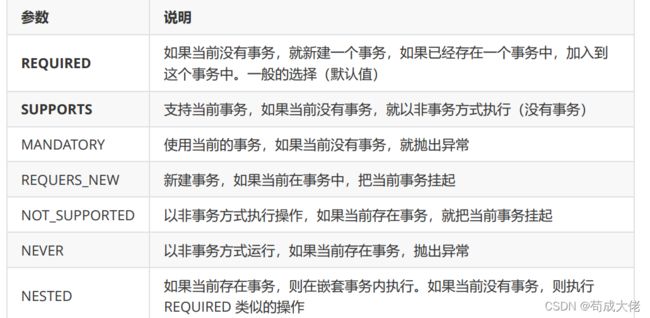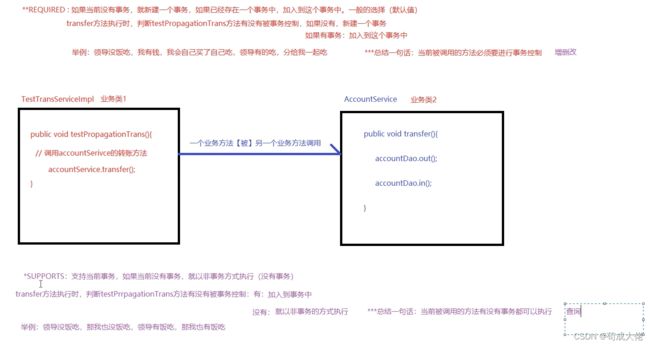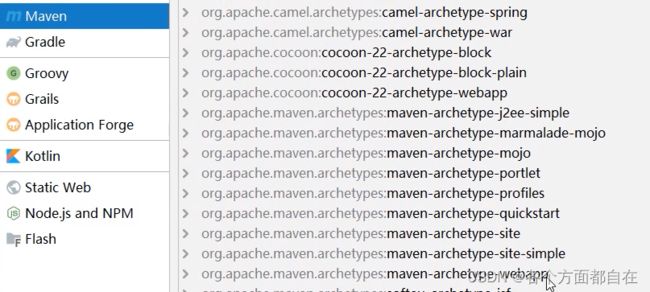Spring的JDBCTemplate与声明式事务
Spring的JdbcTemplate:
除了前面说过的连接池来操作数据库连接,Spring也提供了类似的操作,如下
JdbcTemplate是什么?
JdbcTemplate是spring框架中提供的一个模板对象,是对原始繁琐的Jdbc API对象的简单封装
核心对象:
JdbcTemplate jdbcTemplate = new JdbcTemplate(DataSource dataSource);
核心方法:
举个栗子:
查询数据库所有账户信息到Account实体中:
public class JdbcTemplateTest {
@Test
public void testFindAll() throws Exception {
JdbcTemplate jdbcTemplate = new JdbcTemplate(JdbcUtils.getDataSource());
String sql = "select * from account";
List<Account> list = jdbcTemplate.query(sql, new BeanPropertyRowMapper<>(Account.class));
}
}
Spring整合JdbcTemplate :
需求
基于Spring的xml配置实现账户的CRUD案例
步骤分析:
创建java项目,导入坐标 :
<dependencies>
<dependency>
<groupId>mysqlgroupId>
<artifactId>mysql-connector-javaartifactId>
<version>5.1.47version>
dependency>
<dependency>
<groupId>com.alibabagroupId>
<artifactId>druidartifactId>
<version>1.1.15version>
dependency>
<dependency>
<groupId>org.springframeworkgroupId>
<artifactId>spring-contextartifactId>
<version>5.1.5.RELEASEversion>
dependency>
<dependency>
<groupId>org.aspectjgroupId>
<artifactId>aspectjweaverartifactId>
<version>1.8.13version>
dependency>
<dependency>
<groupId>org.springframeworkgroupId>
<artifactId>spring-jdbcartifactId>
<version>5.1.5.RELEASEversion>
dependency>
<dependency>
<groupId>org.springframeworkgroupId>
<artifactId>spring-txartifactId>
<version>5.1.5.RELEASEversion>
dependency>
<dependency>
<groupId>junitgroupId>
<artifactId>junitartifactId>
<version>4.12version>
dependency>
<dependency>
<groupId>org.springframeworkgroupId>
<artifactId>spring-testartifactId>
<version>5.1.5.RELEASEversion>
dependency>
dependencies>
编写Account实体类:
package com.domain;
public class Account {
private Integer id;
private String name;
private Double money;
@Override
public String toString() {
return "Account{" +
"id=" + id +
", name='" + name + '\'' +
", money=" + money +
'}';
}
public Integer getId() {
return id;
}
public void setId(Integer id) {
this.id = id;
}
public String getName() {
return name;
}
public void setName(String name) {
this.name = name;
}
public Double getMoney() {
return money;
}
public void setMoney(Double money) {
this.money = money;
}
}
编写AccountDao接口和实现类:
package com.dao;
import com.domain.Account;
import java.util.List;
public interface AccountDao {
public List<Account> findAll();
public Account findById(Integer id);
public void save(Account account);
public void update(Account account);
public void delete(Integer id);
}
package com.dao.impl;
import com.dao.AccountDao;
import com.domain.Account;
import org.springframework.beans.factory.annotation.Autowired;
import org.springframework.jdbc.core.BeanPropertyRowMapper;
import org.springframework.jdbc.core.JdbcTemplate;
import java.util.List;
@Repository
public class AccountDaoImpl implements AccountDao {
@Autowired
private JdbcTemplate jdbcTemplate;
@Override
public List<Account> findAll() {
String sql = "select * from account";
List<Account> query = jdbcTemplate.query(sql, new BeanPropertyRowMapper<Account>
(Account.class));
return query;
}
@Override
public Account findById(Integer id) {
String sql = "select * from account where id = ?";
Account account = jdbcTemplate.queryForObject(sql, new BeanPropertyRowMapper<Account>
(Account.class), id);
return account;
}
@Override
public void save(Account account) {
String sql = "insert into values(null,?,?)";
jdbcTemplate.update(sql, account.getName(), account.getMoney());
}
@Override
public void update(Account account) {
String sql = "update account set name = ?,money = ? where id = ?";
jdbcTemplate.update(sql, account.getName(), account.getMoney(), account.getId());
}
@Override
public void delete(Integer id) {
String sql = "delete from account where id = ?";
jdbcTemplate.update(sql, id);
}
}
编写AccountService接口和实现类:
package com.service;
import com.domain.Account;
import java.util.List;
public interface AccountService {
public List<Account> findAll();
public Account findById(Integer id);
public void save(Account account);
public void update(Account account);
public void delete(Integer id);
}
package com.service.impl;
import com.dao.AccountDao;
import com.service.AccountService;
import com.domain.Account;
import org.springframework.beans.factory.annotation.Autowired;
import org.springframework.stereotype.Service;
import java.util.List;
@Service
public class AccountServiceImpl implements AccountService {
@Autowired
private AccountDao aDao;
public void setAccountDao(AccountDao accountDao) {
this.aDao = accountDao;
}
@Override
public List<Account> findAll() {
return aDao.findAll();
}
@Override
public Account findById(Integer id) {
return aDao.findById(id);
}
@Override
public void save(Account account) {
aDao.save(account);
}
@Override
public void update(Account account) {
aDao.update(account);
}
@Override
public void delete(Integer id) {
aDao.delete(id);
}
}
编写spring核心配置文件 :
jdbc.driverClassName=com.mysql.jdbc.Driver
jdbc.url=jdbc:mysql:///spring_db?characterEncoding=utf8
jdbc.username=root
jdbc.password=123456
<beans xmlns="http://www.springframework.org/schema/beans"
xmlns:xsi="http://www.w3.org/2001/XMLSchema-instance"
xmlns:context="http://www.springframework.org/schema/context"
xsi:schemaLocation="
http://www.springframework.org/schema/beans
http://www.springframework.org/schema/beans/spring-beans.xsd
http://www.springframework.org/schema/context
http://www.springframework.org/schema/context/spring-context.xsd">
<context:component-scan base-package="com.lagou">context:component-scan>
<context:property-placeholder location="classpath:jdbc.properties"/>
<bean id="dataSource" class="com.alibaba.druid.pool.DruidDataSource">
<property name="driverClassName" value="${jdbc.driverClassName}">property>
<property name="url" value="${jdbc.url}">property>
<property name="username" value="${jdbc.username}">property>
<property name="password" value="${jdbc.password}">property>
bean>
<bean id="jdbcTemplate" class="org.springframework.jdbc.core.JdbcTemplate">
<constructor-arg name="dataSource" ref="dataSource">constructor-arg>
bean>
beans>
编写测试代码:
package com.lagou.test;
import com.lagou.domain.Account;
import com.lagou.service.AccountService;
import org.junit.Test;
import org.junit.runner.RunWith;
import org.springframework.beans.factory.annotation.Autowired;
import org.springframework.test.context.ContextConfiguration;
import org.springframework.test.context.junit4.SpringJUnit4ClassRunner;
import java.util.List;
@RunWith(SpringJUnit4ClassRunner.class)
@ContextConfiguration("classpath:applicationContext.xml")
public class AccountServiceTest {
@Autowired
private AccountService accountService;
@Test
public void testSave(){
Account account = new Account();
account.setName("张三");
account.setMoney(1000.0);
accountService.save(account);
}
@Test
public void testFindAll(){
List<Account> all = accountService.findAll();
for (Account account : all) {
System.out.println(account);
}
}
@Test
public void testFindOne(){
Account account = accountService.findById(1);
System.out.println(account);
}
@Test
public void testUpdate(){
Account account = new Account();
account.setId(1);
account.setName("李四");
account.setMoney(2000.0);
accountService.update(account);
}
@Test
public void testDelete(){
accountService.delete(4);
}
}
实现转账案例:
步骤分析:
创建java项目,导入坐标 :
<dependencies>
<dependency>
<groupId>mysqlgroupId>
<artifactId>mysql-connector-javaartifactId>
<version>5.1.47version>
dependency>
<dependency>
<groupId>com.alibabagroupId>
<artifactId>druidartifactId>
<version>1.1.15version>
dependency>
<dependency>
<groupId>org.springframeworkgroupId>
<artifactId>spring-contextartifactId>
<version>5.1.5.RELEASEversion>
dependency>
<dependency>
<groupId>org.aspectjgroupId>
<artifactId>aspectjweaverartifactId>
<version>1.8.13version>
dependency>
<dependency>
<groupId>org.springframeworkgroupId>
<artifactId>spring-jdbcartifactId>
<version>5.1.5.RELEASEversion>
dependency>
<dependency>
<groupId>org.springframeworkgroupId>
<artifactId>spring-txartifactId>
<version>5.1.5.RELEASEversion>
dependency>
<dependency>
<groupId>junitgroupId>
<artifactId>junitartifactId>
<version>4.12version>
dependency>
<dependency>
<groupId>org.springframeworkgroupId>
<artifactId>spring-testartifactId>
<version>5.1.5.RELEASEversion>
dependency>
dependencies>
编写Account实体类:
package com.lagou.domain;
public class Account {
private Integer id;
private String name;
private Double money;
@Override
public String toString() {
return "Account{" +
"id=" + id +
", name='" + name + '\'' +
", money=" + money +
'}';
}
public Integer getId() {
return id;
}
public void setId(Integer id) {
this.id = id;
}
public String getName() {
return name;
}
public void setName(String name) {
this.name = name;
}
public Double getMoney() {
return money;
}
public void setMoney(Double money) {
this.money = money;
}
}
编写AccountDao接口和实现类:
package com.lagou.dao;
public interface AccountDao {
public void outMoney(String outUser, double money);
public void inMoney(String inUser, double money);
}
package com.lagou.dao.impl;
import com.lagou.dao.AccountDao;
import org.springframework.beans.factory.annotation.Autowired;
import org.springframework.jdbc.core.JdbcTemplate;
import org.springframework.stereotype.Repository;
@Repository
public class AccountDaoImpl implements AccountDao {
@Autowired
private JdbcTemplate jdbcTemplate;
@Override
public void outMoney(String outUser, double money) {
String sql = "update account set money = money - ? where name = ?";
jdbcTemplate.update(sql, money, outUser);
}
@Override
public void inMoney(String inUser, double money) {
String sql = "update account set money = money + ? where name = ?";
jdbcTemplate.update(sql, money, inUser);
}
}
编写AccountService接口和实现类:
package com.lagou.service;
public interface AccountService {
public void transfer(String outUser, String inUser, Double money);
}
package com.lagou.service.impl;
import com.lagou.dao.AccountDao;
import com.lagou.service.AccountService;
import org.springframework.beans.factory.annotation.Autowired;
import org.springframework.stereotype.Service;
@Service
public class AccountServiceImpl implements AccountService {
@Autowired
private AccountDao accountDao;
@Override
public void transfer(String outUser, String inUser, Double money) {
accountDao.outMoney(outUser, money);
accountDao.inMoney(inUser, money);
}
}
编写spring核心配置文件:
jdbc.driverClassName=com.mysql.jdbc.Driver
jdbc.url=jdbc:mysql:///spring_db?characterEncoding=utf8&useSSL=false
# 加上useSSL=false防止使用注解时,出现的关闭错误,默认是true
jdbc.username=root
jdbc.password=123456
<beans xmlns="http://www.springframework.org/schema/beans"
xmlns:xsi="http://www.w3.org/2001/XMLSchema-instance"
xmlns:context="http://www.springframework.org/schema/context"
xsi:schemaLocation="
http://www.springframework.org/schema/beans
http://www.springframework.org/schema/beans/spring-beans.xsd
http://www.springframework.org/schema/context
http://www.springframework.org/schema/context/spring-context.xsd">
<context:component-scan base-package="com.lagou">context:component-scan>
<context:property-placeholder location="classpath:jdbc.properties"/>
<bean id="dataSource" class="com.alibaba.druid.pool.DruidDataSource">
<property name="driverClassName" value="${jdbc.driverClassName}">property>
<property name="url" value="${jdbc.url}">property>
<property name="username" value="${jdbc.username}">property>
<property name="password" value="${jdbc.password}">property>
bean>
<bean id="jdbcTemplate" class="org.springframework.jdbc.core.JdbcTemplate">
<constructor-arg name="dataSource" ref="dataSource">constructor-arg>
bean>
beans>
编写测试代码:
package com.lagou.test;
import com.lagou.service.AccountService;
import org.junit.Test;
import org.junit.runner.RunWith;
import org.springframework.beans.factory.annotation.Autowired;
import org.springframework.test.context.ContextConfiguration;
import org.springframework.test.context.junit4.SpringJUnit4ClassRunner;
@RunWith(SpringJUnit4ClassRunner.class)
@ContextConfiguration("classpath:applicationContext.xml")
public class AccountServiceTest {
@Autowired
private AccountService accountService;
@Test
public void textTransfer(){
accountService.transfer("李四","jerry",100d);
}
}
Spring的事务 :
Spring中的事务控制方式:
Spring的事务控制可以分为编程式事务控制和声明式事务控制
编程式:
开发者直接把事务的代码和业务代码耦合到一起,在实际开发中不用
声明式:
开发者采用配置的方式来实现的事务控制,业务代码与事务代码实现解耦合,使用的AOP思想
编程式事务控制相关对象:
PlatformTransactionManager:
PlatformTransactionManager接口,是spring的事务管理器,里面提供了我们常用的操作事务的方法

注意:
TransactionDefinition :
TransactionDefinition接口提供事务的定义信息(事务隔离级别、事务传播行为等等)

事务隔离级别:
设置隔离级别,可以解决事务并发产生的问题,如脏读、不可重复读和虚读(幻读)
事务传播行为:
事务传播行为指的就是当一个业务方法【被】另一个业务方法调用时,应该如何进行事务控制

事务挂起,相当于将对应连接保存起来,后面再自己进行相应操作,如创建连接等等再次进行事务操作
注意:是有上面设置的方法的传播(有对应事务管理,这是需要对应判断),即其他方法没有对应设置,就当作一个普通方法而已
而加入,就相当于判断,然后是否进行连接的创建或者开启事务等等

TransactionStatus:
TransactionStatus 接口提供的是事务具体的运行状态

可以简单的理解三者的关系:事务管理器通过读取事务定义参数进行事务管理,然后会产生一系列的事务状态
实现代码:
配置文件:
<bean id="transactionManager"
class="org.springframework.jdbc.datasource.DataSourceTransactionManager">
<property name="dataSource" ref="dataSource"/>
bean>
业务层代码:
package com.lagou.service.impl;
import com.lagou.dao.AccountDao;
import com.lagou.service.AccountService;
import org.springframework.beans.factory.annotation.Autowired;
import org.springframework.stereotype.Service;
import org.springframework.transaction.PlatformTransactionManager;
import org.springframework.transaction.TransactionDefinition;
import org.springframework.transaction.TransactionStatus;
import org.springframework.transaction.support.DefaultTransactionDefinition;
@Service
public class AccountServiceImpl implements AccountService {
@Autowired
private AccountDao accountDao;
@Autowired
private PlatformTransactionManager transactionManager;
@Override
public void transfer(String outUser, String inUser, Double money) {
DefaultTransactionDefinition def = new DefaultTransactionDefinition();
def.setReadOnly(false);
def.setIsolationLevel(TransactionDefinition.ISOLATION_REPEATABLE_READ);
def.setPropagationBehavior(TransactionDefinition.PROPAGATION_REQUIRED);
TransactionStatus status = transactionManager.getTransaction(def);
try {
accountDao.outMoney(outUser, money);
accountDao.inMoney(inUser, money);
transactionManager.commit(status);
} catch (Exception e) {
e.printStackTrace();
transactionManager.rollback(status);
}
}
}
知识小结:
Spring中的事务控制主要就是通过这三个API实现的
理解三者的关系:事务管理器通过读取事务定义参数进行事务管理,然后会产生一系列的事务状态
基于XML的声明式事务控制:
在 Spring 配置文件中声明式的处理事务来代替代码式的处理事务。底层采用AOP思想来实现的
声明式事务控制明确事项:
核心业务代码(目标对象,切入点是谁?
事务增强代码(Spring已提供事务管理器,通知是谁?)
切面配置(切面如何配置?)
快速入门 :
需求
使用spring声明式事务控制转账业务
步骤分析:
引入tx命名空间,事务管理器通知配置,事务管理器AOP配置:
<beans xmlns="http://www.springframework.org/schema/beans"
xmlns:xsi="http://www.w3.org/2001/XMLSchema-instance"
xmlns:context="http://www.springframework.org/schema/context"
xmlns:tx="http://www.springframework.org/schema/tx"
xmlns:aop="http://www.springframework.org/schema/aop"
xsi:schemaLocation="
http://www.springframework.org/schema/beans
http://www.springframework.org/schema/beans/spring-beans.xsd
http://www.springframework.org/schema/context
http://www.springframework.org/schema/context/spring-context.xsd
http://www.springframework.org/schema/tx
http://www.springframework.org/schema/tx/spring-tx.xsd
http://www.springframework.org/schema/aop
http://www.springframework.org/schema/aop/spring-aop.xsd">
<context:component-scan base-package="com.lagou">context:component-scan>
<context:property-placeholder location="classpath:jdbc.properties"/>
<bean id="dataSource" class="com.alibaba.druid.pool.DruidDataSource">
<property name="driverClassName" value="${jdbc.driverClassName}">property>
<property name="url" value="${jdbc.url}">property>
<property name="username" value="${jdbc.username}">property>
<property name="password" value="${jdbc.password}">property>
bean>
<bean id="jdbcTemplate" class="org.springframework.jdbc.core.JdbcTemplate">
<constructor-arg name="dataSource" ref="dataSource">constructor-arg>
bean>
<bean id="transactionManager"
class="org.springframework.jdbc.datasource.DataSourceTransactionManager">
<property name="dataSource" ref="dataSource"/>
bean>
<tx:advice id="advice" transaction-manager="transactionManager">
<tx:attributes>
<tx:method name="*"/>
tx:attributes>
tx:advice>
<aop:config>
<aop:advisor advice-ref="advice" pointcut="execution(*
com.lagou.service.impl.AccountServiceImpl.*
(..))"/>
aop:config>
beans>
测试事务控制转账业务代码:
@Test
public void textTransfer(){
accountService.transfer("李四","jerry",100d);
}
事务参数的配置详解(对应的片段) :
<tx:advice id="advice" transaction-manager="transactionManager">
<tx:attributes>
<tx:method name="transfer" isolation="REPEATABLE_READ" propagation="REQUIRED"
timeout="-1"
read-only="false"/>
<tx:method name="save*" propagation="REQUIRED"/>
<tx:method name="delete*" propagation="REQUIRED"/>
<tx:method name="update*" propagation="REQUIRED"/>
<tx:method name="find*" read-only="true"/>
<tx:method name="*"/>
tx:attributes>
tx:advice>
知识小结:
基于注解的声明式事务控制:
常用注解:
步骤分析:
修改service层,增加事务注解:
@Override
@Transactional(propagation = Propagation.REQUIRED,isolation = Isolation.REPEATABLE_READ,timeout =
-1,readOnly = false)
public void transfer(String outUser, String inUser, Double money) {
accountDao.outMoney(outUser, money);
accountDao.inMoney(inUser, money);
}
若加在类上,如
@Service
public class AccountServiceImpl implements AccountService {
}
添加对应的spring核心配置文件,开启事务注解支持:
<tx:annotation-driven>tx:annotation-driven>
注意:在依赖里,若要使用配置文件,不要加上packaging标签,如:
<groupId>com.lagougroupId>
<artifactId>jdbc_springartifactId>
<packaging>pompackaging>
<version>1.0-SNAPSHOTversion>
最后要注意:IOC和AOP都是一种方式,也就是说,可以单独使用的,而不是只有他们一起
而在Spring里AOP基本需要IOC的使用,主要是因为AOP基本只会操作IOC的实例,或者说操作IOC比较方便
纯注解:
核心配置类:
package com.lagou.config;
import org.springframework.beans.factory.annotation.Autowired;
import org.springframework.context.annotation.Bean;
import org.springframework.context.annotation.ComponentScan;
import org.springframework.context.annotation.Configuration;
import org.springframework.context.annotation.Import;
import org.springframework.jdbc.core.JdbcTemplate;
import org.springframework.jdbc.datasource.DataSourceTransactionManager;
import org.springframework.transaction.PlatformTransactionManager;
import org.springframework.transaction.annotation.EnableTransactionManagement;
import javax.sql.DataSource;
@Configuration
@ComponentScan("com.lagou")
@Import(DataSourceConfig.class)
@EnableTransactionManagement
public class SpringConfig {
@Bean
public JdbcTemplate getJdbcTemplate(@Autowired DataSource dataSource) {
JdbcTemplate jdbcTemplate = new JdbcTemplate(dataSource);
return jdbcTemplate;
}
@Bean
public PlatformTransactionManager getTransactionManager(@Autowired DataSource dataSource) {
DataSourceTransactionManager dataSourceTransactionManager = new
DataSourceTransactionManager(dataSource);
return dataSourceTransactionManager;
}
}
package com.lagou.config;
import com.alibaba.druid.pool.DruidDataSource;
import org.springframework.beans.factory.annotation.Value;
import org.springframework.context.annotation.Bean;
import org.springframework.context.annotation.PropertySource;
import javax.sql.DataSource;
@PropertySource("classpath:jdbc.properties")
public class DataSourceConfig {
@Value("${jdbc.driverClassName}")
private String driverClassName;
@Value("${jdbc.url}")
private String url;
@Value("${jdbc.username}")
private String username;
@Value("${jdbc.password}")
private String password;
@Bean
public DataSource dataSource() {
DruidDataSource dataSource = new DruidDataSource();
dataSource.setDriverClassName(driverClassName);
dataSource.setUrl(url);
dataSource.setUsername(username);
dataSource.setPassword(password);
return dataSource;
}
}
测试类:
package com.lagou.test;
import com.lagou.config.SpringConfig;
import com.lagou.service.AccountService;
import org.junit.Test;
import org.junit.runner.RunWith;
import org.springframework.beans.factory.annotation.Autowired;
import org.springframework.test.context.ContextConfiguration;
import org.springframework.test.context.junit4.SpringJUnit4ClassRunner;
@RunWith(SpringJUnit4ClassRunner.class)
@ContextConfiguration(classes = SpringConfig.class)
public class AccountServiceTest {
@Autowired
private AccountService accountService;
@Test
public void textTransfer(){
accountService.transfer("李四","jerry",100d);
}
}
知识小结:
Spring集成web环境:
ApplicationContext应用上下文获取方式
应用上下文对象是通过 new ClasspathXmlApplicationContext(spring配置文件) 方式获取的
但是每次从容器中获得Bean时都要编写 new ClasspathXmlApplicationContext(spring配置文件)
这样的弊端是配置文件加载多次,应用上下文对象创建多次
解决思路分析:
在Web项目中,可以使用ServletContextListener监听Web应用的启动,我们可以在Web应用启动时
就加载Spring的配置文件,创建应用上下文对象ApplicationContext
在将其存储到最大的域servletContext域中,这样就可以在任意位置从域中获得应用上下文ApplicationContext对象了
Spring提供获取应用上下文的工具:
上面的分析不用手动实现,Spring提供了一个监听器ContextLoaderListener就是对上述功能的封装
该监听器内部加载Spring配置文件,创建应用上下文对象,并存储到ServletContext域中
提供了一个客户端工具WebApplicationContextUtils供使用者获得应用上下文对象
所以我们需要做的只有两件事:
在web.xml中配置ContextLoaderListener监听器(导入spring-web坐标)
使用WebApplicationContextUtils获得应用上下文对象ApplicationContext
实现:
创建工程时,可以点击如下来创建web工程:

前提将这个勾选才可点击:

对应依赖,就是对应jar包,封装好了对应操作,网上依赖千千万万,一般外面需要某个jar包时
需要对应jar,而pom.xml帮我们操作了,由于非常多,只要知道大概的jar就可以了
导入Spring集成web的坐标
<dependencies>
<dependency>
<groupId>org.springframeworkgroupId>
<artifactId>spring-contextartifactId>
<version>5.1.5.RELEASEversion>
dependency>
<dependency>
<groupId>org.springframeworkgroupId>
<artifactId>spring-webartifactId>
<version>5.1.5.RELEASEversion>
dependency>
<dependency>
<groupId>javax.servletgroupId>
<artifactId>javax.servlet-apiartifactId>
<version>3.1.0version>
<scope>providedscope>
dependency>
dependencies>
配置ContextLoaderListener监听器:
<web-app xmlns="http://xmlns.jcp.org/xml/ns/javaee"
xmlns:xsi="http://www.w3.org/2001/XMLSchema-instance"
xsi:schemaLocation="http://xmlns.jcp.org/xml/ns/javaee
http://xmlns.jcp.org/xml/ns/javaee/web-app_4_0.xsd"
version="4.0">
<listener>
<listener-class>org.springframework.web.context.ContextLoaderListenerlistener-class>
listener>
<context-param>
<param-name>contextConfigLocationparam-name>
<param-value>classpath:applicationContext.xmlparam-value>
context-param>
web-app>
通过工具获得应用上下文对象:
package com.lagou.servlet;
import com.lagou.domain.Account;
import org.springframework.web.context.WebApplicationContext;
import org.springframework.web.context.support.WebApplicationContextUtils;
import javax.servlet.ServletException;
import javax.servlet.annotation.WebServlet;
import javax.servlet.http.HttpServlet;
import javax.servlet.http.HttpServletRequest;
import javax.servlet.http.HttpServletResponse;
import java.io.IOException;
@WebServlet("/account")
public class AccountServlet extends HttpServlet {
@Override
protected void doGet(HttpServletRequest req, HttpServletResponse resp) throws ServletException,
IOException {
ClassPathXmlApplicationContext("applicationContext.xml");
WebApplicationContext webApplicationContext =
WebApplicationContextUtils.getWebApplicationContext(req.getServletContext());
Account account = (Account) webApplicationContext.getBean("account");
System.out.println(account);
}
@Override
protected void doPost(HttpServletRequest req, HttpServletResponse resp) throws ServletException,
IOException {
super.doGet(req, resp);
}
}
实体类:
package com.lagou.domain;
public class Account {
private Integer id;
private String name;
private Double money;
@Override
public String toString() {
return "Account{" +
"id=" + id +
", name='" + name + '\'' +
", money=" + money +
'}';
}
public Integer getId() {
return id;
}
public void setId(Integer id) {
this.id = id;
}
public String getName() {
return name;
}
public void setName(String name) {
this.name = name;
}
public Double getMoney() {
return money;
}
public void setMoney(Double money) {
this.money = money;
}
}
ount");
WebApplicationContext webApplicationContext =
WebApplicationContextUtils.getWebApplicationContext(req.getServletContext());
Account account = (Account) webApplicationContext.getBean("account");
System.out.println(account);
}
@Override
protected void doPost(HttpServletRequest req, HttpServletResponse resp) throws ServletException,
IOException {
super.doGet(req, resp);
}
}
实体类:
package com.lagou.domain;
public class Account {
private Integer id;
private String name;
private Double money;
@Override
public String toString() {
return "Account{" +
"id=" + id +
", name='" + name + '\'' +
", money=" + money +
'}';
}
public Integer getId() {
return id;
}
public void setId(Integer id) {
this.id = id;
}
public String getName() {
return name;
}
public void setName(String name) {
this.name = name;
}
public Double getMoney() {
return money;
}
public void setMoney(Double money) {
this.money = money;
}
}






